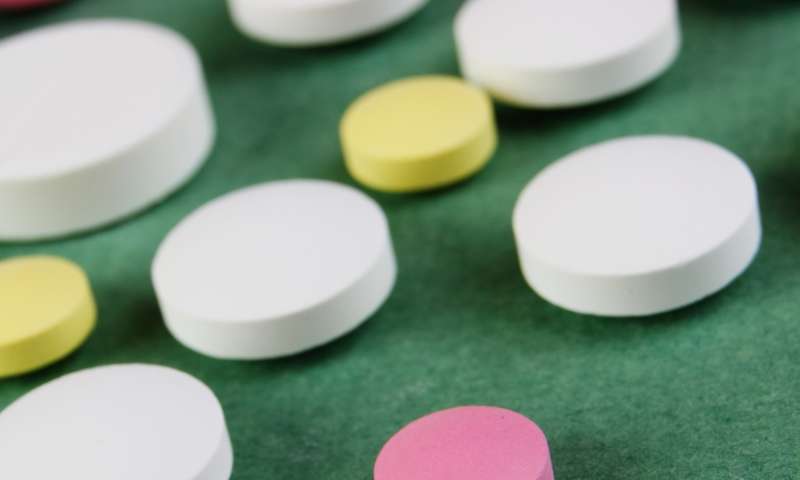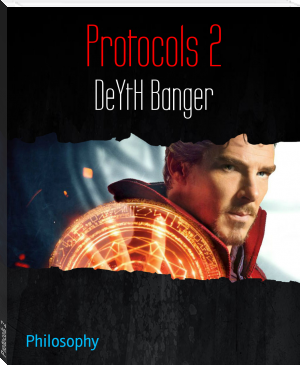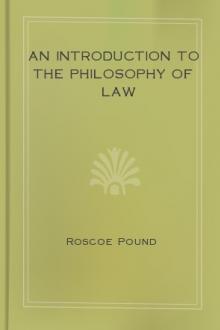Protocols by DeYtH Banger, Clive Cooper (best inspirational books .TXT) 📖

- Author: DeYtH Banger, Clive Cooper
Book online «Protocols by DeYtH Banger, Clive Cooper (best inspirational books .TXT) 📖». Author DeYtH Banger, Clive Cooper
For example, omega-3 fatty acids, which are lipid building blocks found in foods like salmon and walnuts, are known to be especially good for heart and liver health. There is evidence that when people eat omega-3 fatty acids, the cellular membranes into which they are incorporated are less likely to overreact to signals from the immune system than membranes comprised of other kinds of lipids. This has an anti-inflammatory effect that could prevent heart or liver disease.
Farber and Quinlivan's method allowed them to delve into these kinds of connections. They were able to tag different kinds of lipids, feed them to live zebrafish, and then watch what the fish did with them.
"If we fed the fish a specific type of fat, our technique allowed us to determine into what molecules these lipids were reassembled after they were broken down in the small intestine and in which organs and cells these molecules ended up," Farber explained.
The tags they used were fluorescent. So Farber and Quinlivan and their team were actually able to see the fats that they fed their zebrafish glowing under the microscope as they were broken down and reassembled into new molecules in different organs. Further experiments allowed them to learn into what types of molecules the broken down fat components were incorporated.
"Being able to do microscopy and biochemistry in the same experiment made it easier to understand the biological meaning of our results," Quinlivan said. "We hope our method will allow us to make further breakthroughs in lipid biochemistry going forward."
Provided by: Carnegie Institution for Science
New way to detect ecstasy discovered May 8, 2017 by Birgitte Svennevig
Credit: University of Southern Denmark
While building molecular machines, researchers stumbled upon a new method to detect ecstasy. The discovery can lead to more reliable drug tests.
Researchers at the University of Southern Denmark, the Polytechnic University of Valencia and the Biomedical Research Networking Center in Bioengineering, Biomaterials & Nanomedicine (CIBER-BBN) in Spain have discovered a new technique to detect ecstasy that is extremely reliable and simple to use.
According to the researchers, many of the testing methods used today often require advanced instruments that are expensive and/or only found in laboratories. Often, there is also a waiting time in connection with the test results. Furthermore, there is also the recurring issue that many methods trigger a false positive a little too often - i.e. showing that a person tested positive for ecstasy even though subsequent tests show otherwise.
- It is our impression that a need exists for more reliable, user-friendly and cheaper tests. What makes our method stand out is that it can detect even small traces, said Jan O. Jeppesen, a chemistry professor at the University of Southern Denmark.
New testing kits
His research colleagues, Ramón Martínez-Máñez and Félix Sancenón from the Polytechnic Univeristy of Valencia and the CIBER-BBN in Spain, also noted that their method had several advantages.
- We have discovered that a certain molecular activity can detect even very small traces of the active compound in ecstasy, MDMA, with almost 100 percent certainty. This knowledge can be used to develop cheap testing kits that are easy to transport and not least use.
The researchers' new method can detect a solution equivalent to 1 gram of MDMA in 1000 litres of water.
They have recently published their findings and method in the Royal Society of Chemistry journal Chemical Communications.
Moving molecules
Jeppesen and his research team at the Department of Physics, Chemistry and Pharmacy at the University of Southern Denmark are working on understanding and building parts for molecular machines - near-unimaginably tiny machines propelled by the movement of molecules. It was during this work that they discovered the molecules' ability to detect MDMA.
It is a research area that is attracting a great deal of attention from all over the world, and the 2016 Nobel Prize in Chemistry went to the chemists Jean-Pierre Sauvage, J. Fraser Stoddart and Bernard L. Feringa for their work on building machines on a molecular level.
The opportunities that lie in the field of molecular machines are huge, according to Jeppesen.
- The moment you let a molecular machine replace an electric machine, for example, you end up with a much smaller piece of machinery to operate. As a way of illustrating this, consider the following: If we assume that 6 billion people on Earth each possesses 10 computers in one shape or another, those computers will take up an enormous amount of space. If we could instead use molecules to replace all this computer technology, the molecular technology would only take up half a gram of weight.
How the test works
You start with a ball composed of atoms, which is simple to make. The ball is porous and filled with holes, meaning it can be filled up with smaller molecules. In this method, the ball is filled with molecules that are designed to light up if they are released from the holes.
If there is no MDMA (methylenedioxymethamphetamine, the active ingredient in ecstasy) within range, the molecules cannot leave the ball. This is because a kind of arm is installed on the exterior of the ball that can open the ball's pores once it comes into contact with MDMA and keeps the molecules sealed in until that happens.
When the ball 'opens up', so to speak, the luminescent molecules stream out and can be detected by a sensor.
The ball only opens up once it comes into contact with MDMA, and it can detect even minuscule concentrations of MDMA.
More information: Beatriz Lozano-Torres et al, Pseudorotaxane capped mesoporous silica nanoparticles for 3,4-methylenedioxymethamphetamine (MDMA) detection in water, Chem. Commun. (2017). DOI: 10.1039/C7CC00186J
Provided by: University of Southern Denmark
SCP - Part 3SCP Files
The Talk
Eli woke an indeterminate amount of time later. Groggily, he turned his head to the side. Stainless steel equipment, wires tied neatly to the vertices where the clean white wall met the clean white ceiling. The sick bay. He groaned.
The noise caught Dictator and Oliver’s attentions. Dictator stood more quickly than normal and went to him.
“You’re up. How d’you feel?”
“Like shit,” he answered. He noticed that Dictator’s hand was moving. So was their foot. Every fibre of their being vibrated with nervous energy.
Dictator took a deep breath, and some of the tension dissipated. “Alright. Eli, listen to me. We have to fix this.” The tension returned. Dictator put planted their hands on Eli's shoulders, looking him seriously in the eyes. “We've got to fix this, there's no way around it. I don't care what they say about that stupid clock but we're gonna fix the universe, got it? We just have to. That's our job, isn’t it? It’s supposed to-”
Eli reached up and put his hand on their mouth. They didn’t even bother to lick it, which told Eli quite a bit about their mental state. “Dictator,” he said. “I got it. We are going to fix this. It’s all going to work itself out.”
He removed his hand, but Dictator launched right back into their tirade.
“But what if it doesn't? Eli, I can't die.” They lowered their voice. “You can't die. If the universe collapses in on us, we'll both be left just floating in space forever. Just the two of us. I doubt you want to be looking at this mug for the rest of eternity, and I’m not-”
Eli hijacked Dictator’s in-between-paragraphs breath. “You need to calm down,” he told them. “We’re going to find out what’s happened, if it even means anything. It might be nothing. But we need to get the whole story before we start losing our shit here, alright? Now, please get off me. I’m an invalid, and some of the aides are starting to look at you funny.”
Dictator nodded, then crossed their arms and sat back down in the chair next to Eli's bed. Their leg started bouncing anxiously again, and they muttered “Gonna fix it, gonna fix it,” at least five times before quieting.
—-
That damn clock. Why did it have to reveal everything? Well, maybe not everything. It didn't say my name, but… now everyone's on high alert. They're ready for a breach.
The unknown doctor strode down the darkened hallway. His footsteps echoed through the empty space, and once he found the door he was looking for, he swiftly unlocked it and walked inside. His hands worked the opposing wall, searching. They found their target, and he watched as the walls folded in on themselves, revealing a modestly-lit room. He looked behind him. No one. He retreated inside and the walls whirred and clicked to his absence, like batter rushing to fill the void where a spoon once was.
No matter what that clock says, I'm going to tear this Foundation down from the inside out. Nothing, not even the end of the universe, is going to stop me. And if I can manage to take down those two abominations, all the better for me. We've all been under the heel of the Foundation for too long. The public — no, the world — deserves to know about the evils that haunt this world.
A dark chuckle echoed through the room.
Yes. My plan will bring down the Foundation once and for all. No amount of cover-ups or amnestics is going to stop what is about to happen.





Comments (0)